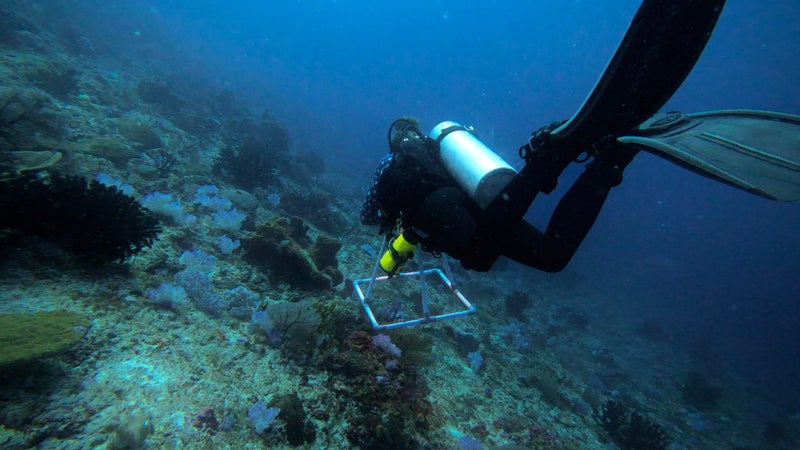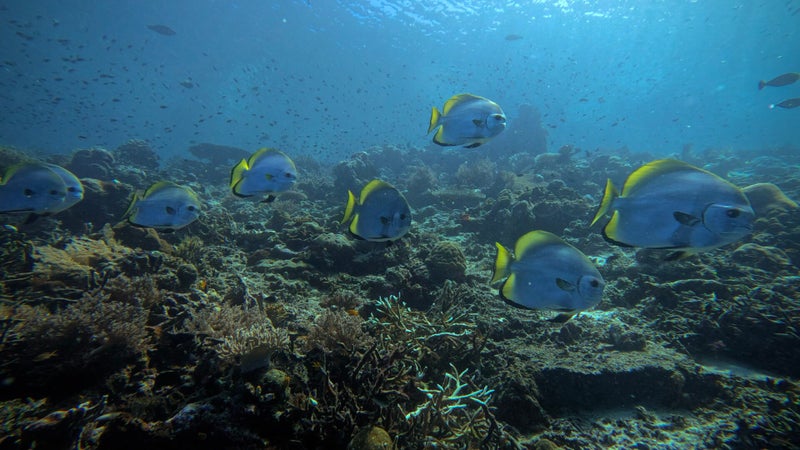Week 1
Day 1 & 2: First Impressions
My first couple of days with Indo Ocean Project in Raja Ampat were a bit of a whirlwind. After flying straight in from Brussels with barely any sleep over three days, I arrived completely exhausted. On top of that, stepping into a completely unfamiliar place filled with unfamiliar people added to the overwhelm.
Once we arrived, we were able to settle in a bit. I got assigned a bunk in a shared dorm with other interns. Most of them had already been here for a while, working on their Divemaster course after having done their Advanced or Rescue training. The dorm itself is a basic wooden hut, no air conditioning, just fans, so it’s very much back to basics. I’ve done rustic living before, like during my time at Chagar Hutang, but this felt different. At Chagar, I knew what to expect and was returning as someone familiar with the place. Here, everything was new, and that made the transition a bit harder.
I’m sharing the dorm with five other people. That doesn’t sound like a lot, but since most are in their 18 to early 20s and have been here for a while, the space was completely cluttered with everyone’s stuff, it felt chaotic and honestly pretty overwhelming at first.
My first impression of the group was mixed. I arrived with two other new interns (a Dutch guy and an Italian girl) and we bonded quickly, which was a relief. But the rest of the group felt pretty closed off. While a few people were friendly and introduced themselves, some made us feel like a burden. I get that they’ve been here for a while and have their routines and friend groups, but I don’t think they realise how hard it is to arrive as a newcomer and try to integrate into that dynamic. One girl was actually quite rude from the get-go, which left a bad taste in my mouth.
There wasn’t much of a structured welcome or orientation from IOP itself, so Day 1 and 2 felt like a bit of a guessing game. Apparently Day 2 was a day off, so we weren’t officially starting the program until Day 3. That left us kind of figuring things out on our own.
Since everyone else had planned a full-day outing for Day 2, I decided to stay behind and rest, probably the best choice I could’ve made. With the place quiet and most people gone, I was able to breathe, relax, and recharge a bit without feeling overwhelmed by the crowd.


Day 3: Refresher Dive and Settling In
Finally, on day 3, we got our proper introduction to the Indo Ocean Project and how everything runs here. In the morning, we were shown around the dive centre, walked through the schedule, and given the rundown of what our next weeks will look like. We also got our gear sorted—BCDs, regulators, wetsuits, fins, fitted and ready to go.
Then came the refresher dive, which is required for everyone before starting the rest of the dives. We were introduced to the 24 scuba skills that we’d need to demonstrate underwater, everything from regulator recovery to mask removal. I’ll be honest: I was dreading the full mask removal. Even with 50+ dives under my belt, it still freaks me out (and apparently I’m not alone, nobody enjoys that one). But once I got through it, everything went smoothly.
We ended up staying underwater for a solid 74 minutes, which was amazing.
Socially, things are starting to look up, too. A few people in the group have been really kind and open, and I’m slowly finding my place. Hopefully, it only gets better from here.
Day 4: First Boat Dive and Pygmy Devil Ray
Today was my first proper dive day, two boat dives scheduled for scientific surveys (focusing on spotting and identifying sharks, turtles, rays, and fish). Since we’re just getting started, they counted as fun dives for us, which I was definitely not complaining about.
The first dive? Incredible. The reef was bursting with life, so many fish, vibrant coral, and then… a pygmy devil ray! Apparently, that’s a big deal. Some of the staff here at Raja Ampat haven’t even seen one yet, so it felt unreal to have that kind of luck on our first real dive. We also saw great barracudas and giant trevallies cruising around.
During our surface interval, we stopped at a beautiful beach before heading back in for the second dive.
The second one was tougher. The current was a lot stronger, and since I didn’t have a reef hook yet, I got caught by surprise and slammed into the rocks at one point. It was only for a couple of seconds, but yeah, it shook me up a bit. Still, we managed to spot a few more big players: two blacktip reef sharks, another group of great barracudas, and a giant trevally.
After the dive, we got a really helpful debrief on how to handle strong currents, which made me feel more confident for next time.


Day 5 & 6: DM Training Begins, BRUV Dive and Community Chaos (in a good way)
Day 5 marked the official start of my Divemaster (DM) training. First up: skill demonstrations. There are 24 of them, everything from clearing your mask to emergency ascents, basically all the core skills students learn in Open Water or Advanced courses. As a DM trainee, I need to be able to demonstrate them clearly and confidently so students can copy me. Each skill has its own hand signal (because, you know, underwater charades), and there’s a specific sequence to follow.My instructor ran through all of them first, and then I had a go. Surprisingly, I did better than I expected, only had to redo three. Most of the feedback I got was about polishing little things, but overall I felt calm and comfortable underwater, which is half the battle already.
Day 6 was back on the boat for two dives. This time, no fun diving, we were doing benthic surveys, a first for me. That basically means logging different types of seafloor habitats and structures along a transect. It… could’ve gone better. But it’s all part of the learning curve, and I’ve got 7 more weeks to improve. The second dive was about logging megafauna like rays, sharks, and turtles, and WOW. I genuinely don’t think I’ve ever seen that many fish in one place. Picture a school of over 50 giant trevallies gliding past. We spotted a few blacktip reef sharks and a couple of green sea turtles too


In the afternoon, I got a last-minute invite to help with community outreach in a nearby village. IOP runs regular sessions to build relationships with the local communities, teaching kids English, sustainability, and marine conservation in fun, interactive ways. It was chaotic (as any event with 30+ kids tends to be), but they were adorable and so excited. Total heart-melter of a day.



Day 7: Species ID Overload
Today was a full-on species identification class: sharks, rays, reef fish, whales, dolphins… basically everything that swims in Raja Ampat. Normally I’d be super into this kind of thing, but of course, I woke up feeling sick this morning. So sitting still and trying to concentrate for over six hours wasn’t exactly ideal.The kicker? We’ll be tested on all of it throughout our stay here. Four tests, 20 questions each… and you’re only allowed one mistake per test. Pressure’s on.
We wrapped up the day with a first round of practice questions, and… yeah, it didn’t go great. Even the species I usually know by heart, sharks, turtles, somehow escaped me. I think my brain just gave up by that point. It left me feeling a bit stressed, to be honest. But I guess that’s my cue to hit the books (or the species ID sheets) a little harder. Why is this all so important? Because during survey dives, we have to be able to spot, name, count, and size key marine species on the go. Which sounds straightforward, but trust me, it’s way harder than it sounds when you’re 20 meters underwater and everything is zooming past you.
Can’t believe it’s already been a week here though. Feels like I’ve been here forever and also just arrived yesterday. Time is weird.




Create Your Own Website With JouwWeb